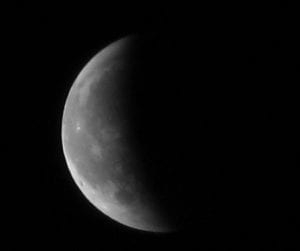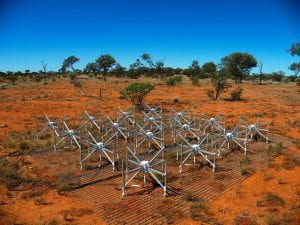Assistant Professor of Physics Jonathan Pober is working with NASA to build a radio telescope array to unlock the secrets of the Cosmic Dark Ages.

By Pete Bilderback
PROVIDENCE, R.I. [Brown University] —The secrets of the Cosmic Dark Ages, a period following the Big Bang, may be found on the far side of the moon, and Assistant Professor of Physics Jonathan Pober will be helping NASA to unlock them. Pober has been awarded a prestigious Nancy Grace Roman Technology Fellowship (RTF) in Astrophysics for early researchers, the aim of which is to help young researchers develop innovative technologies that have the potential to enable major scientific breakthroughs in the future.
The award will support Pober in advancing the ambitious agenda of building a giant radio telescope array on the far side of the moon. Pober explained, “Generally, we can do radio astronomy from the ground, the Earth’s atmosphere is pretty forgiving to radio waves. Neutral hydrogen has a 21-centimeter wavelength, and wavelengths of that size can go straight through the Earth’s atmosphere with no issues.”
But there’s a catch that has to do with the fact that the universe has been expanding ever since the Big Bang. “We’re looking for signals from back when the universe was one-tenth its current size,” said Pober. And critically, wavelengths expand along with the universe, a phenomenon known as redshifting. “And so, as the universe expanded to its current size, a 21-centimeter wave stretched into a two-meter wave,” he noted. “And at two meters, the Earth’s atmosphere starts to become a bit of a nuisance.”
“But we want to look way back in cosmic history to a time when the universe was one hundredth its current size – the Cosmic Dark Ages when there were no galaxies, no stars, no planets.” Pober explained, “and the wavelengths stretched along with the universe as they’ve traveled to us. So now we’re talking about a 20-meter wavelength, and that absolutely can’t make it through the Earth’s atmosphere. And so the idea that we’ve been steadily trying to build the case for is building a very, very large radio telescope on the far side of the moon.”
An ultra-long-wavelength radio telescope on the far side of the moon would have tremendous advantages over Earth-based telescopes beyond being able to observe longer wavelengths. “The Earth will be obscured,” Pober explained, and “the moon will block radio and television signals.” It will also block noise from Earth-orbiting satellites, the ionosphere, and the sun’s noise during the solar night. “If you can get an experiment there, it’s a fantastic place to do ultra-low frequency or ultra-long wavelength radio astronomy,” said Pober.
While there is not yet a formal NASA mission, NASA is exploring the concept of building a large antenna array on the far side of the moon. Such a mission is incredibly ambitious because, in addition to being located on the far side of the moon, in order to be sensitive to long radio wavelengths, the telescope will need to be gigantic. The plan is to build an array of thousands of radio telescopes on the far side of the moon, where it will be shielded from all of the radio noise produced on Earth. One such NASA-funded mission concept being developed by Pober and collaborators is FarView, with a primary objective “focused upon investigation in exquisite detail the unexplored Cosmic Dark Ages using the highly redshifted hydrogen 21-cm line and identifying the conditions and processes under which the first stars, galaxies, and accreting black holes formed.”
The Cosmic Dark Ages began approximately 400,000 years following the Big Bang when the universe cooled enough to form neutral hydrogen and helium atoms. During this period, which ended when protogalaxies produced enough light to ionize the universe about a billion years after the Big Bang, the universe was enveloped by a fog of neutral hydrogen that trapped all light.
Any light from this period cannot reach the Earth, so the only way for humans to peer back into this period is using radio telescopes. Cosmologists currently know very little about this period, but it could hold the answers to some of science’s biggest mysteries. NASA claims FarView “could give extraordinarily precise measurements of the early structure of the universe because the sea of neutral hydrogen from which protogalaxies formed can be directly imaged using radio waves.”
No equivalent observatory exists today. According to NASA, “This radio telescope will be the first of its kind at this scale and sensitivity and will open a new window (low-frequency radio) into the early universe, analogous to the detection of gravitational waves by LIGO [Laser Interferometer Gravitational-Wave Observatory] and the details of the CMB [cosmic microwave background] by Planck.”

Pober does not have any immediate plans to visit the far side of the moon. He estimates that if everything goes perfectly, the earliest the project could be completed would be in thirty years’ time. “It’s an ambitious project,” he said, “this grant is just for simulation and design of a future experiment that could be on the far side of the moon.” “The first couple of radio antennas will be landing on the moon in the next couple of years as pathfinders,” Pober noted. “Those are just to show that radio astronomy can be done from the moon, but to actually do the science we want, we’ll need to have hundreds of thousands of radio antennas on the far side of the moon.”
There will be enormous logistical challenges involved in building such a large array in a difficult-to-reach location. “You have to change the antenna design to make them deployable,” Pober said. “Because people aren’t going to go to the far side of the moon to set them up. The deployment will need to be automated, so a lot of this grant will involve figuring out how that will work.”
While the timescale for the project is long, the RTF grant will allow Pober to make important contributions to advancing the design of the array. “A successful mission design will require a team with expertise in radio antenna design, space systems engineering, astrophysical cosmology, and data science,” Pober said. “The RTF will provide funding to assemble key personnel with expertise spanning these areas, delivering key technological advances to make this concept a reality.”